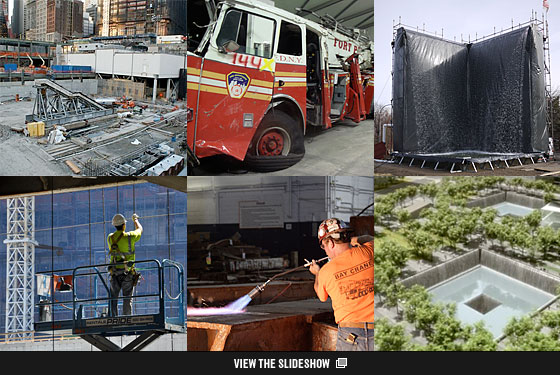
Photographs by Steve Rosenbaum
On the morning of September 11, 2001, documentarian Steven Rosenbaum was readying two video crews in the Flatiron district to shoot a movie about dogs for Animal Planet. Then the planes hit, and he and his staff rushed downtown. Rosenbaum instructed them all to shoot whatever others seemed not to be shooting, and the result was poignant, difficult footage not of the disaster itself but of New Yorkers reckoning with the immediate aftermath. Combined with amateur video donated by others, the result was the acclaimed documentary film 7 Days in September, which he calls “maybe the most personal thing I’ve ever done. It wasn’t political and it wasn’t hand-wringy and it wasn’t nationalistic. It was just very matter-of-fact about those seven days. I really did think the world was ending and I’d make something and stick it away in a time capsule and someone would dig it up in a hundred years.”
A few years later, Rosenbaum realized he had 500 hours of 9/11-related video, probably more than anyone in the world. In 2004, he donated the educational rights to the entire archive to the National September 11th Memorial and Museum. It will become the cornerstone of the museum’s digital collection. Along the way, Rosenbaum embarked on a new 9/11 project, this one focused on the memorial. Rosenbaum, at his own expense, has been videotaping the construction of the center (which is scheduled to open by the tenth anniversary of the attacks). He has shot the creation of the two eight-story-deep waterfalls demarcating the footprints of the two towers—“the largest man-made moving water anywhere in the United States,” he says—and he has spent more time than perhaps any other layman in the eight underground acres that will house the museum. “Those spaces are just magnificent and haunting; they have ghosts, they’re powerful,” he says. The memorial’s senior staff, he says, “care about details you’ll never possibly notice when you first walk into the museum. I’ve come to believe that what they’re making will surprise even some of the most vocal critics.”
So far, Rosenbaum has about 130 hours of footage, plus a voluminous photo archive. Some of the photos of the memorial’s construction will be published as a book; pictured here are other photos of the center’s artifacts, stored in Hangar 17 at Kennedy airport. Over the next few months, the memorial’s staff will be making final decisions about what will be lowered by crane into the museum. Then the earth above, at ground zero, will be sealed over like a tomb, and the official memorial of one day in September will be nearly—finally—complete.
Hangar 17
An abandoned hangar once used by Tower Air, Hangar 17 at JFK is now home to some of the largest and most profoundly disturbing artifacts in the world. While most of us saw the Towers fall, either as it happened or in one of the many endless replays, you can’t understand the scale of the destruction until you stand next to massive pieces of steel, bent and twisted from the terrible force of the collapse. Pieces of the building’s façade—known as the “Tridents,” with “save” scrawled on their rusting steel—are being prepared to return to the site. In the sealed, tented airplane hangar, crushed fire trucks, ambulances, and even a taxi cab await their return to the underground museum. There’s even an entire PATH subway car. In one corner of the hangar, a large table serves as a command center for the restoration team, who are working to protect and preserve the fragile reminders and quickly fading posters that once adorned what is now known as “the last column.”
The Pools
The two massive “voids” that will be the centerpiece of the memorial will be placed exactly on the footprint of where the towers stood. Architect Michael Arad designed the memorial, which will have the names of the victims etched into the brass plates that ring the outer edge of the pools. A continuous flow of water will create a four-sided waterfall, with black slate on the sides and the bottom of the two pools.